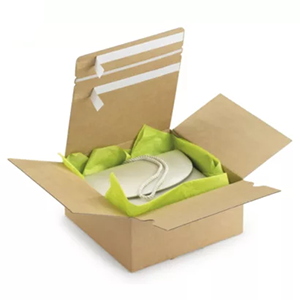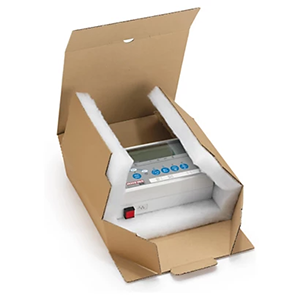Do you use your boxes for export or do they have a long logistics or supply chain? Then you should think about reinforcing them! Even the most robust 2- or 3-wall carton for export is only as secure as its closure. If a conventional packing tape is damaged during transport, even a small tear can cause it to tear completely in the long run. This means that your contents are no longer optimally protected against falling out or unwanted access. Threads can be helpful here, because a thread can be strong. Anyone who has ever tried to tear off a loose thread end from a garment with their bare hands knows this. And it is almost impossible to cut several threads at the same time, no matter how thin they are. This effect is worked into several packing tapes to your advantage!
Thread reinforcement with polyester threads
Thread-reinforced PP packaging tapes, for example, guarantee very high tear resistance due to sealed-in polyester threads. The tape is therefore suitable for sealing medium to heavy packaging. And it does so so reliably that material can be saved with this packaging tape, because just one strip is enough for security! In the case of wet adhesive tape (the backing material is paper, the adhesive consists of plant glue), the reinforcement ensures that this adhesive tape, which is naturally easy to tear, is also thread-reinforced and suitable for sealing medium-weight to heavy cardboard boxes.
Filament: glass-fibre threads make the adhesive tape tough
The adhesive tape with the highest tear strength, however, is the filament tape: here, glass fibres are incorporated either lengthwise or lengthwise and crosswise. This results in a tear strength of up to 575 Newton per 25 millimetres. Filament tape is therefore particularly suitable for sealing heavy and even hazardous goods packaging, including for export.
The term “filament” comes from Latin and means “threadwork”. It thus describes the secret of reinforced adhesive tape quite accurately: additional fibres made of silicon (i.e. glass) are incorporated into the polypropylene (PP) adhesive tape. That is why in this case one speaks of glass-fibre reinforced plastic. The PP tape in itself already has good properties for secure sealing: it has a high adhesive strength and a high tear resistance. However, it is susceptible to damage. If a PP tape is punctured under tension, it tears completely, unlike PVC packing tape. The famous biros test shows this:
Tested resilience
To test the load-bearing capacity of an adhesive tape in terms of tear strength, there are special testing machines that take a 25mm wide piece of adhesive tape to its limits. To do this, the tape is clamped at both ends and the tension is continuously increased. And as I said, the filament tape can withstand a pull of up to 575 Newtons – which corresponds to a force of almost 60kg!
But the load capacity can also be impressively demonstrated with the simple biros test: In this test, the adhesive tapes are pierced under tension with a biro or another pointed object. If the tape tears completely, it is usually a polypropylene (PP) packaging tape. If only a hole remains, the tape is made of polyvinyl chloride (PVC).
Filament ribbons in the test
Filament tapes combine the positive properties of PP tape with high tear strength and resistance to damage:
A filament tape will not tear if punctured or otherwise damaged. The incorporated bundles of numerous wafer-thin glass fibres arranged in parallel (also called “roving”) have a much higher tear strength and stop the tape from tearing further. Even a cut or tear at the edge of the tape cannot harm the filament tape.
Filament tape with longitudinal reinforcement
They are extremely resistant to penetration, despite perforation the PP tape does not tear.
Despite damage, it cannot be torn in the transverse direction, but it can be torn in the longitudinal direction.
Filament tape with reinforcement in transverse and longitudinal direction
Filament tapes with reinforcement in the transverse and longitudinal directions are extremely resistant to penetration. They cannot be pierced with a biro. Despite being pierced with a very pointed object, the PP tape does not tear.
It cannot be torn in either the transverse or longitudinal direction – despite damage.
The glass fibre threads have a higher tensile strength than the backing material and therefore increase the overall tensile strength, i.e. the load that a tape can withstand before it breaks. Another important indicator for the resistance of a packing tape is the elongation at break. This describes by how many percent an adhesive tape lengthens under load before it tears. The Supra Plus tape is also reinforced, but with polyester threads instead of glass threads. With an elongation at break of 165%, it can be stretched by more than half its length before it tears. It is therefore very “tough” because it is stretchable. However, a higher elongation at break can also be a disadvantage: If a package is to be securely closed and thus protected from unauthorised access, for example, the adhesive tape should yield and thus reveal as little as possible.
So if you want to be on the safe side when shipping, you should choose a tape reinforced with glass fibre in the longitudinal and transverse directions. No matter what your packaging has to go through, your tape will remain intact and your shipment will arrive safely sealed and protected.
















